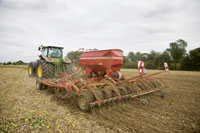Seed rate increase makes sense on blackgrass land

Last minute tweaks to seed rates, or even delaying drilling for a couple of weeks can make a surprising difference to blackgrass control in wheat, Masstock trials have shown.
The firm has been investigating the value of various different cultural control techniques primarily at its Stow Longa site, near Huntingdon in Cambridgeshire for the past few seasons, including taking the trials to yield.
The main focus has been investigating a variety’s competitiveness and the benefit in increasing seed rates on blackgrass control, explains Colin Lloyd, Masstock’s research development manager.
Initial trials compared Robigus – a variety known to have higher biomass and thought to be competitive, with Hereward, which is a shy tillerer and less competitive. Each was drilled at three seed rates – 175, 270 and 350 seeds / sq m. None of the plots received any herbicides.
Both increasing seed rate and using the more competitive variety had an impact on blackgrass control. Increasing the seed rate from 175 to 350 seeds / sq m raised blackgrass control in Hereward by around 20%, while switching variety to the more competitive Robigus made a 40% difference. “Those results have been repeatable over the past seven years,” Mr Lloyd says.
That was true last year, although the cold winter and slow start to growth in the spring did decrease the competitive ability of varieties, he notes. “Last year the difference in control between the highest seed rate of Robigus and the lowest seed rate of Hereward was around 40% compared with the 50% we usually see.”
Unlike most herbicide comparisons, the trials were taken to yield. “On this site, we reckon around 100 blackgrass heads per sq m equates to a loss in yield of around 1t/ha, although that figure could vary at other sites.”
For example, this season, the higher seed rate Robigus yielded 0.43t/ha more than the low seed rate, which was infested with 50 more blackgrass plants per sq m, while the high rate Hereward yielded 0.49t/ha more than its low rate counterpart with a similar difference in blackgrass heads per sq m.
A second series of trials has looked at variety performance at one seed rate (270 seeds / sq m). Those trials were sprayed with a pre-emergence herbicide and either Atlantis or Lexus plus Stomp post-emergence. The Atlantis + Stomp treatment is designed to give some indication of the genetic yield potential, while the Lexus + Stomp helps pull out differences in competitiveness of each variety, Mr Lloyd says.
In each of the four years Oakley has been the top yielding variety, showing off not only its high inherent yield, but its competitiveness against blackgrass. “A lot of Oakley is being grown in bad blackgrass areas.”
JB Diego, along with Robigus, are other competitive varieties, the research suggests.
Competitiveness is not just about a variety having a prostrate leaf habit, which tiller profusely, although both characteristics are important, Mr Lloyd adds. “Speed of movement in the spring is also important. For example, Claire, which tillers a lot and is prostrate provides relatively poor competition because its speed of movement in the spring is poor.”
Slow development also explains why Grafton, which yields around 2% more than Warrior on the current Recommended List, is nearly a 1t/ha down in the Stow Longa trials, he says.
Other less competitive varieties in blackgrass situations include Kingdom and Panorama. “I’m not saying don’t drill these varieties if they are valuable in your system, but it would pay to avoid them on the worst blackgrass fields, or delay drilling where possible.”
Delaying drilling on the site from the third week of September to the second week of October can give up to 50% control of blackgrass, he points out. “It makes sense to delay drilling of the worst fields, and to tweak seed rates up to help with competitiveness.”
That can increase lodging and disease risks, he admits. “But it should be nothing you cannot handle in a normal situation with good agronomy.”
Establishment method investigated
The effect of establishment technique on blackgrass control will be investigated at Stow Longa this season. Strips 24m wide will be drilled with a Lemken combi-drill, after either being ploughed, or min-till established with either a single pass with a set of discs, or in a two pass system with an additional pass with a set of tines set to 10-12in, Mr Lloyd says. A further 24m strip will be direct drilled using a Claydon.
Across each strip herbicide programmes will be overlaid, and the strips monitored for three seasons for the impact on weed control.

